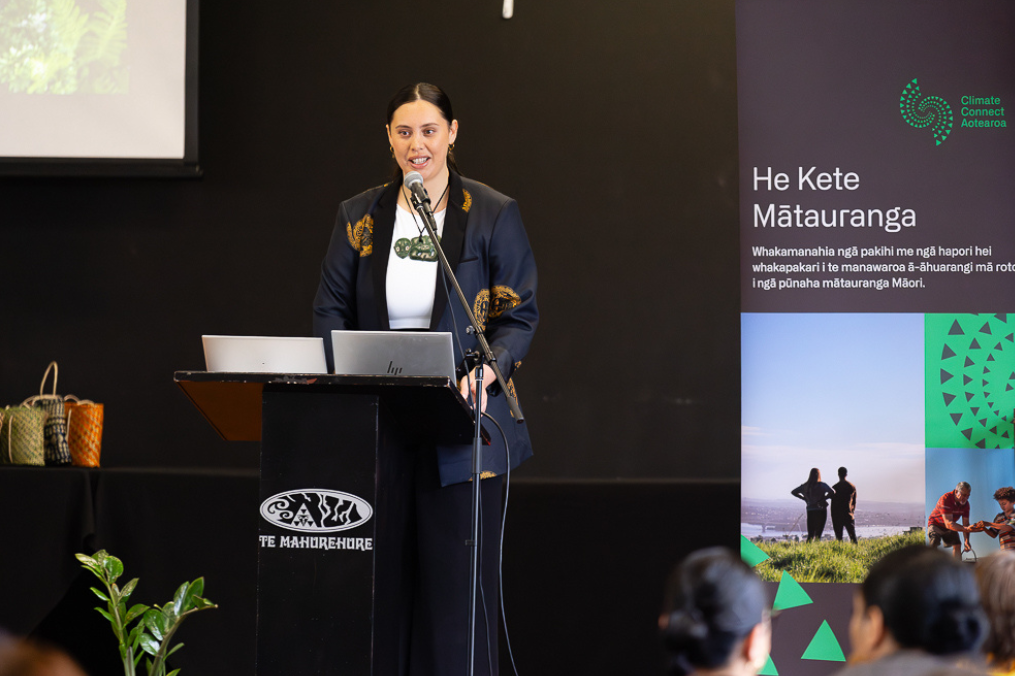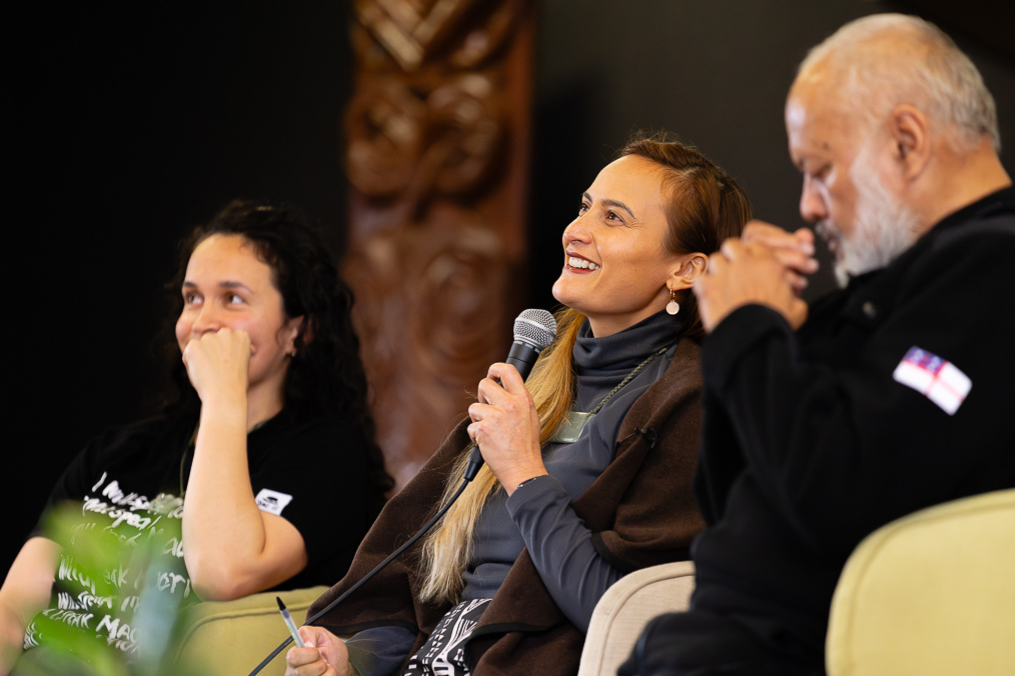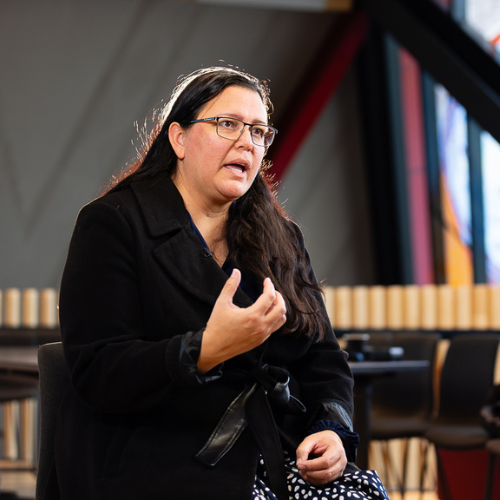In 2023, Climate Connect Aotearoa established He Kete Mātauranga – an online space designed to support businesses and communities in building climate resilience through Māori knowledge. Through a series of video interviews, we connected with leaders and innovators within te ao Māori and explored what mātauranga Māori meant to them and the role it played in their climate action. On Wednesday, 5 June, we came together to bring these discussions to life.
Intent on creating a safe space for Māori to wānanga and connect, we welcomed over 115 people who represented Māori businesses, universities, iwi, and governance bodies in Tāmaki Makaurau. Our hui was held at Te Mahurehure Cultural Marae, including their new contemporary whare – Taumata o Kupe. It featured a multi-coloured glass window wall, etched with the stories of atua Māori, including the infamous navigator, Kupe. Welcoming our guests into this space seemed appropriate as it was a visual representation of mātauranga Māori and innovation – a physical embodiment of our kaupapa expressed through modern design.
The three main themes of our hui were mātauranga Māori, climate innovation and te anamata – the future. We were incredibly honoured to present a stellar lineup of Māori experts and practitioners in science, innovation and of course, mātauranga Māori.
Climate Innovation Advisor Māori, Waimarama Hawke (Ngāti Whātua Ōrākei, Ngāti Pikiao, Ngāti Awa, Ngāti Ranginui, Ngāti Mahuta, Ngāti Maniapoto), co-designer and MC of He Kete Mātauranga, shares her personal reflection of the hui, including highlights and favourite moments.

Waimarama Hawke (Ngāti Whātua Ōrākei, Ngāti Pikiao, Ngāti Awa, Ngāti Ranginui, Ngāti Mahuta, Ngāti Maniapoto)
Mātauranga Māori
Rereata Makiha (Ngāti Pakau, Ngai Tuteauru, Ngāti Hau) was the first keynote speaker of the day. Recognised as a mātanga or expert in Māori astrology – it was fitting to have him open the discussion regarding mātauranga Māori. He echoed the narrative that it does not have one true definition. Dynamic, fluid, and personal in nature, mātauranga Māori encompasses a wide range of kōrero, practices and beliefs that are articulated differently between iwi, hapū and whānau. This grounded the discussions to come as all panellists shared their own unique interpretations of mātauranga Māori.
Rereata also spoke to the power of storytelling, our original method of knowledge transmission. He said that within each pūrākau or story, there were kura huna – encoded messages that held important knowledge about our world. It was up to each person to find those kura huna and apply them to their everyday living. Glancing across the room, I could see people eagerly trying to unravel the kura huna in his kōrero.

Rereata Makiha (Ngāti Pakau, Ngai Tuteauru, Ngāti Hau)
Dan Hikuroa (Ngāti Maniapoto, Ngāti Mahuta, Ngāti Whanaunga, Pākehā), Hana Tapiata (Tūhourangi, Ngāti Tarāwhai) and Ayla Hoeta (Waikato Tainui, Ngāti Tahinga) joined Rereata to continue in further wānanga on the mātauranga Māori panel. It was here that I noticed a strong theme of mana wahine. The importance of women in our connection to the taiao was highlighted – not only as givers of life but as the most natural leaders in fostering a healthy relationship with our environment.
This was explored in more depth by Hana Tapiata who shared kōrero from her second book ‘Atua Wahine: The Ancient Wisdom of Māori Goddesses,’ set to be released in September. She shared that “all the Māori models of time are governed by Atua Wahine”: from Hinetītama at dawn to Hine-nui-te-pō at night, yet we know so little about them. Hana went on to say that if we don’t know them well – we cannot truly know ourselves, affirming that we are inherently connected to our atua.

Hana Tapiata (Tūhourangi, Ngāti Tarāwhai)
Furthermore, if we do not know our atua, it is difficult to understand their behaviour in the taiao. To this point, maramataka practitioner, Ayla Hoeta shared that there are constant tohu or signals around us, but we need to know our taiao well to see and hear them. She emphasised the importance of being attuned to these tohu. A practice of hers, taught to her by Papa Rereata is kaitirotiro – a traditional methodology for observing the environment. In addition to observing with our eyes, Ayla encouraged the audience to also observe with our hearts, and our wairua too.

Ayla Hoeta (Waikato Tainui, Ngāti Tahinga)
Climate Innovation
The second keynote speaker of the day was Dr Pauline Harris (Rongomaiwahine, Ngāti Kahungunu ki Wairoa, Ngāti Rakaipaaka). Pauline is an astrophysicist who is endeavouring on a 6–month study with Nasa to explore Māori environmental monitoring, advanced data analytics and the use of space-based observations in maramataka Māori.
In her presentation, she shared the 2021 Māori Climate Change Report – He Huringa Āhuarangi, He Huringa Ao, and summarised the ways in which climate change impacts Māori. It was evident that negative changes to native ecosystems in Aotearoa have a direct influence on Māori health, culture, and identity. I took particular interest in her kōrero on data sovereignty. Within a Māori context, there is an understanding that data is more than numbers and statistics, especially when it concerns place and people. If we are to collect data about our world – it needs to be done in a Māori way.

Dr Pauline Harris (Rongomaiwahine, Ngāti Kahungunu ki Wairoa, Ngāti Rakaipaaka)
Pauline was joined by Troy Brockbank (Te Rarawa, Ngāti Hine, Ngāpuhi, Ngāti Wai, Ngāti Kahu), Te Mana o te Wai Lead at Beca and Emily Afoa (Ngāpuhi, Ngāti Maniapoto) who is the Pou Whakarae at Tektus Consultants. Together, they explored the meaning of innovation. Troy shared that “innovation isn’t about creating something new”. Rather, it is about using everything we know, especially kōrero tuku iho or ancestral knowledge, and looking to the past to inform how we move into the future.
Emily referred to innovation as (k)new knowledge. In her work – things like green infrastructure and water-sensitive design are viewed as new and innovative. However, she says that these are simply the ways in which we used to live in harmony with the taiao. Ensuring that they are guided by whakaaro Māori is something that this Panel strives to do, albeit in Pākehā spaces. One of the quotes that I appreciated from Troy was that “knowledge isn’t knowledge unless it is shared” – placing further emphasis on the importance of a hui like He Kete Mātauranga.

From left: Troy Brockbank (Te Rarawa, Ngāti Hine, Ngāpuhi, Ngāti Wai, Ngāti Kahu), Emily Afoa (Ngāpuhi, Ngāti Maniapoto), Dr Pauline Harris (Rongomaiwahine, Ngāti Kahungunu ki Wairoa, Ngāti Rakaipaaka)
Te Anamata
The final keynote speaker of the day was Hinerapa Rupuha (Ngāti Kahungunu, Te Whānau a Apanui, Rangitāne). Pursuing the ancient art of waka hourua, Hinerapa shared her personal journey as a student of Te Kura o Ngā Kurī a Tarawhata where she learns about non-instrumental waka voyaging. For Hinerapa, navigation is a space that combines all her passions in one – from mātauranga Māori to science and maths. In her presentation, I learned the value of practical knowledge. As children we are introduced to stars like Puanga and Takurua and stories like that of Māui and the sun, however it is through experience that the deeper meaning and value of these stories come to light. For Hinerapa, it was through waka that she truly understood the importance of these stories. The practical application of mātauranga Māori made her believe in the power of our knowledge. Complementing the theme of storytelling – Hinerapa likened mōteatea or traditional chants to maps with kura huna or hidden treasures throughout. This further reinforced the idea that our most natural and innate ways of understanding the world, like mōteatea and pūrākau, are our best way forward.

Hinerapa Rupuha (Ngāti Kahungunu, Te Whānau a Apanui, Rangitāne)
Te Huia Taylor (Ngāti Te Ata Waiohua, Te Waiariki) and brother duo, Haukapuanui and Sonny Vercoe (Te Arawa, Tūwharetoa, Te Atihaunui-a-Pāpārangi, Ngāti Kahungunu, Ngāti Pāhauwera, Ngāti Raukawa, Ngāi Tahu) joined Hinerapa for the final panel – Te Anamata. One notable thing about this panel was that all speakers were products of the kōhanga reo and kura kaupapa Māori movements. Fluent in te reo Māori and raised on their respective marae – it was clear that the foundations to their success was being immersed in te ao Māori. When asked of the importance of mātauranga Māori in their work, they all said they knew no other way.

From left: Sonny and Haukapuanui Vercoe (Te Arawa, Tūwharetoa, Te Atihaunui-a-Pāpārangi, Ngāti Kahungunu, Ngāti Pāhauwera, Ngāti Raukawa, Ngāi Tahu)
Haukapuanui shared that whilst te ao Māori worldviews are always at the forefront of his work, he can walk confidently in te ao Pākehā too. This was supported by Te Huia who referred to her generation as kaitakawaenga – people who are confident in Pākehā and Māori spaces and have the ability to bring two worlds together, without needing to merge them. She ended the panel discussion by emphasising the importance of intergenerational resilience – something that we can use to push boundaries, pilot progress and create meaningful change.
“We need to be that bridge that brings those two words together. We are able to navigate both, without needing to merge them” - Te Huia Taylor

Te Huia Taylor (Ngāti Te Ata Waiohua, Te Waiariki)
The value of mātauranga Māori
In an effort to inspire self-belief and foster whanaungatanga, we held this hui for Māori who wanted to learn about and connect through the power of mātauranga Māori. Māori knowledge is often dismissed and considered as a footnote to other systems. With this in mind, He Kete Mātauranga sought to centralise mātauranga Māori – placing it at the forefront and allowing it to guide and inform our climate practices. Whether through indigenous practice like kaitirotiro, (k)new ways of interacting with our atua or using kōrero tuku iho to inform our mahi – mātauranga Māori is critical in fostering a holistic and balanced relationship with our taiao. Through He Kete Mātauranga, Climate Connect Aotearoa will continue to explore the meaning and value of mātauranga Māori and look forward to creating more spaces and opportunities for people to connect, to learn, and to be Māori.
The full line up our programme is available here.


